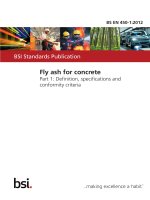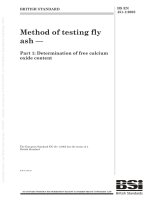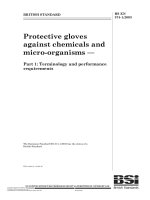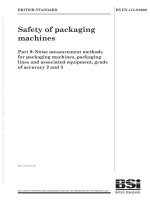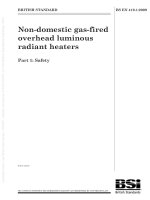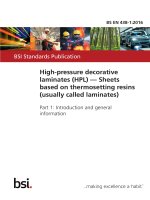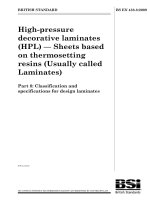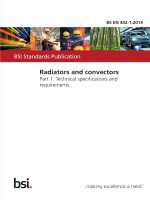Bsi bs en 61857 1 2009
Bạn đang xem bản rút gọn của tài liệu. Xem và tải ngay bản đầy đủ của tài liệu tại đây (1.66 MB, 20 trang )
BS EN 61857-1:2009
BSI British Standards
Electrical insulation systems –
Procedures for thermal
evaluation —
Part 1: General requirements – Low-voltage
NO COPYING WITHOUT BSI PERMISSION EXCEPT AS PERMITTED BY COPYRIGHT LAW
raising standards worldwide™
BRITISH STANDARD
BS EN 61857-1:2009
National foreword
This British Standard is the UK implementation of EN 61857-1:2009. It is
identical to IEC 61857-1:2008. It supersedes BS EN 61857-1:2005 which is
withdrawn.
The UK participation in its preparation was entrusted to Technical Committee
GEL/112, Evaluation and qualification of electrical insulating materials and
systems.
A list of organizations represented on this committee can be obtained on
request to its secretary.
This publication does not purport to include all the necessary provisions of a
contract. Users are responsible for its correct application.
© BSI 2009
ISBN 978 0 580 62003 4
ICS 29.080.30
Compliance with a British Standard cannot confer immunity from
legal obligations.
This British Standard was published under the authority of the Standards
Policy and Strategy Committee on 30 September 2009
Amendments issued since publication
Amd. No.
Date
标准分享网 www.bzfxw.com 免费下载
Text affected
BS EN 61857-1:2009
EUROPEAN STANDARD
EN 61857-1
NORME EUROPÉENNE
January 2009
EUROPÄISCHE NORM
ICS 29.080.30
Supersedes EN 61857-1:2005
English version
Electrical insulation systems Procedures for thermal evaluation Part 1: General requirements Low-voltage
(IEC 61857-1:2008)
Systèmes d'isolation électrique Procédures d'évaluation thermique Partie 1: Exigences générales Basse tension
(CEI 61857-1:2008)
Elektrische Isoliersysteme Verfahren zur thermischen Bewertung Teil 1: Allgemeine Anforderungen Niederspannung
(IEC 61857-1:2008)
www.bzfxw.com
This European Standard was approved by CENELEC on 2008-12-01. CENELEC members are bound to comply
with the CEN/CENELEC Internal Regulations which stipulate the conditions for giving this European Standard
the status of a national standard without any alteration.
Up-to-date lists and bibliographical references concerning such national standards may be obtained on
application to the Central Secretariat or to any CENELEC member.
This European Standard exists in three official versions (English, French, German). A version in any other
language made by translation under the responsibility of a CENELEC member into its own language and notified
to the Central Secretariat has the same status as the official versions.
CENELEC members are the national electrotechnical committees of Austria, Belgium, Bulgaria, Cyprus, the
Czech Republic, Denmark, Estonia, Finland, France, Germany, Greece, Hungary, Iceland, Ireland, Italy, Latvia,
Lithuania, Luxembourg, Malta, the Netherlands, Norway, Poland, Portugal, Romania, Slovakia, Slovenia, Spain,
Sweden, Switzerland and the United Kingdom.
CENELEC
European Committee for Electrotechnical Standardization
Comité Européen de Normalisation Electrotechnique
Europäisches Komitee für Elektrotechnische Normung
Central Secretariat: avenue Marnix 17, B - 1000 Brussels
© 2009 CENELEC -
All rights of exploitation in any form and by any means reserved worldwide for CENELEC members.
Ref. No. EN 61857-1:2009 E
BS EN 61857-1:2009
EN 61857-1:2009
-2-
Foreword
The text of document 112/92/CDV, future edition 3 of IEC 61857-1, prepared by IEC TC 112, Evaluation
and qualification of electrical insulating materials and systems, was submitted to the IEC-CENELEC
parallel vote and was approved by CENELEC as EN 61857-1 on 2008-12-01.
This European Standard supersedes EN 61857-1:2005 and constitutes editorial revisions to make
EN 61857-1:2009 compatible with Parts 21 and 22.
The following dates were fixed:
– latest date by which the EN has to be implemented
at national level by publication of an identical
national standard or by endorsement
(dop)
2009-09-01
– latest date by which the national standards conflicting
with the EN have to be withdrawn
(dow)
2011-12-01
Annex ZA has been added by CENELEC.
__________
Endorsement notice
The text of the International Standard IEC 61857-1:2008 was approved by CENELEC as a European
Standard without any modification.
In the official version, for Bibliography, the following notes have to be added for the standards indicated:
www.bzfxw.com
IEC 60034-18-1
NOTE Harmonized as EN 60034-18-1:1994 (not modified).
IEC 60034-18-21
NOTE Harmonized as EN 60034-18-21:1994 (not modified).
IEC 60034-18-31
NOTE Harmonized as EN 60034-18-31:1994 (not modified).
IEC 62114
NOTE Harmonized as EN 62114:2001 (not modified).
__________
标准分享网 www.bzfxw.com 免费下载
BS EN 61857-1:2009
EN 61857-1:2009
-3-
Annex ZA
(normative)
Normative references to international publications
with their corresponding European publications
The following referenced documents are indispensable for the application of this document. For dated
references, only the edition cited applies. For undated references, the latest edition of the referenced
document (including any amendments) applies.
NOTE When an international publication has been modified by common modifications, indicated by (mod), the relevant EN/HD
applies.
Year
Publication
IEC 60085
2004
Title
EN/HD
Year
1)
Electrical insulation - Thermal classification
EN 60085
2004
Electrical insulating materials - Thermal
endurance properties Part 4-1: Ageing ovens - Single-chamber
ovens
EN 60216-4-1
2006
3)
3)
IEC 60216-4-1
-
2)
IEC 60216-5
-
2)
Electrical insulating materials - Thermal
endurance properties Part 5: Determination of relative thermal
endurance index (RTE) of an insulating
material
EN 60216-5
2008
IEC 60493-1
-
2)
Guide for the statistical analysis of ageing
test data Part 1: Methods based on mean values of
normally distributed test results
-
-
Evaluation and qualification of electrical
insulation systems
EN 60505
IEC 60505
1)
2)
3)
www.bzfxw.com
2004
EN 60085 is superseded by EN 60085:2008, which is based on IEC 60085:2007.
Undated reference.
Valid edition at date of issue.
2004
BS EN 61857-1:2009
–2–
61857-1 © IEC:2008
CONTENTS
INTRODUCTION .....................................................................................................................5
1
Scope ...............................................................................................................................6
2
Normative references........................................................................................................6
3
Terms and definitions .......................................................................................................6
4
General information ..........................................................................................................8
5
4.1
4.2
4.3
Test
Overview of test procedure ......................................................................................8
Basis of evaluation and qualification ........................................................................8
Specific requirements ..............................................................................................8
objects ......................................................................................................................9
6
5.1
5.2
5.3
Test
General ...................................................................................................................9
Description ..............................................................................................................9
Number of test objects .............................................................................................9
procedures................................................................................................................9
7
6.1 General ...................................................................................................................9
6.2 Initial screening tests ...............................................................................................9
6.3 Thermal ageing ..................................................................................................... 10
6.4 Prediagnostic mechanical stress ............................................................................ 11
6.5 Other prediagnostic conditioning ............................................................................ 11
6.6 Moisture exposure ................................................................................................. 12
6.7 Dielectric diagnostic tests ...................................................................................... 12
6.8 Other diagnostic tests ............................................................................................ 12
Analyzing, reporting and classification ............................................................................. 12
www.bzfxw.com
7.1 End-point criterion ................................................................................................. 12
7.2 Method of determining life...................................................................................... 13
7.3 Extrapolation of data.............................................................................................. 13
7.4 Report of results .................................................................................................... 14
Bibliography .......................................................................................................................... 16
Figure 1 – Arrhenius graph for comparing a candidate system C with a reference
system R............................................................................................................................... 15
Table 1 – Suggested ageing temperatures and ageing periods............................................... 10
Table 2 – Thermal class assignment ..................................................................................... 13
标准分享网 www.bzfxw.com 免费下载
BS EN 61857-1:2009
61857-1 © IEC:2008
–5–
INTRODUCTION
This International Standard establishes a standardized test procedure for estimating by
comparison the life expectancy of electrical insulation systems (EIS) in accordance with
IEC 60505.
An EIS contains many different components selected to withstand the varying electrical,
mechanical, and thermal stresses occurring in the different parts of the structure of an
electrotechnical product. The useful life of an EIS depends upon the way that its individual
components are arranged, their interactions upon each other, and the contribution of each
component to the electrical and mechanical integrity of the EIS. Therefore, it is impossible to
specify one test object to represent all electrotechnical products. It is incumbent upon the IEC
equipment technical committees to address the test objects and application of this test
procedure that will meet their specific needs. This work is intended to proceed by cooperation
between this technical committee and other IEC technical committees to develop a series of
parts, each part to address a specific test object and/or application.
This procedure permits approximate comparisons only, and cannot be relied upon to
completely determine the merits of any particular EIS. Such information can be obtained only
from extended service experience.
www.bzfxw.com
BS EN 61857-1:2009
–6–
61857-1 © IEC:2008
ELECTRICAL INSULATION SYSTEMS –
PROCEDURES FOR THERMAL EVALUATION –
Part 1: General requirements – Low voltage
1
Scope
This part of IEC 61857 specifies a general test procedure for the thermal evaluation and
qualification of electrical insulation systems (EIS) and establishes a procedure that compares
the performance of a candidate EIS to that of a reference EIS.
This standard is applicable to existing or proposed EIS used in electrotechnical products with
an input voltage of up to 1 000 V where the thermal factor is the dominating ageing factor.
2
Normative references
The following referenced documents are indispensable for the application of this document. For
dated references, only the edition cited applies. For undated references, the latest edition of
the referenced document (including any amendments) applies.
IEC 60085:2004, Electrical insulation – Thermal evaluation and designation
www.bzfxw.com
IEC 60216-4-1, Electrical insulating materials – Thermal endurance properties – Part 4-1:
Ageing ovens –Single chamber ovens
IEC 60216-5, Electrical insulating materials – Thermal endurance properties – Part 5:
Determination of relative thermal endurance index (RTE) of an insulating material
IEC 60493-1, Guide for the statistical analysis of ageing test data – Part 1: Methods based on
mean values of normally distributed test results
IEC 60505:2004, Evaluation and qualification of electrical insulation systems
3
Terms and definitions
For the purposes of this document, the terms and definitions given in IEC 60505, as well as the
following definitions, apply.
3.1
electrical insulation system
EIS
insulating structure containing one or more electrical insulating materials (EIM) together with
associated conducting parts employed in an electrotechnical device
[IEC 60505, definition 3.1.1]
NOTE EIM with different temperature indices (ATE/RTE according to IEC 60216-5) may be combined to form an
EIS which has a thermal class that may be higher or lower than that of any of the individual components according
to IEC 60505.
3.2
candidate EIS
EIS under evaluation to determine its service capability (thermal)
标准分享网 www.bzfxw.com 免费下载
BS EN 61857-1:2009
61857-1 © IEC:2008
–7–
3.3
reference EIS
established EIS evaluated on the basis of either a known service experience record or a known
comparative functional evaluation
3.4
thermal class
designation of an EIS that is equal to the numerical value of the maximum use temperature in
degrees Celsius (°C) for which the EIS is appropriate (see IEC 60085)
NOTE The EIS may be subjected to operating temperatures exceeding its thermal class which can result in
shorter expected life.
3.5
EIS assessed thermal endurance index
EIS ATE
numerical value of temperature in degrees Celsius for the reference EIS as derived from known
service experience or a known comparative functional evaluation
3.6
EIS relative thermal endurance index
EIS RTE
numerical value of the temperature in degrees Celsius for the candidate EIS which is relative to
the known EIS ATE of a reference EIS, when both EIS are subjected to the same ageing and
diagnostic procedures in a comparative test
3.7
test object
sample of original equipment or part thereof, or model representing the equipment completely
or partially, including the EIS, to be used in a functional test
www.bzfxw.com
3.8
thermal ageing factor
thermal stress that causes irreversible changes of the properties of an EIS
3.9
prediagnostic conditioning
variable or fixed stresses, which can be applied continuously or periodically to an EIS to
enhance the ability of a functional test to detect the degree of ageing
NOTE
Prediagnostic conditioning may cause additional ageing.
3.10
diagnostic test
periodic or continuous application of a specified level of a diagnostic factor to a test object to
determine whether or when the end-point criterion has been reached
3.11
end-point criterion
value of either a property or change of property defining the end of life of a test object in a
functional test
3.12
end-of-life
end of a test object’s life as determined by meeting its end-point criterion
BS EN 61857-1:2009
–8–
4
61857-1 © IEC:2008
General information
4.1
Overview of test procedure
This thermal ageing test procedure is based on the fact that, for most materials, thermal
ageing is accelerated when temperature is raised, and that often the degree of acceleration
obeys the Arrhenius law on chemical reaction rates. Based on this relationship, acceptable
extrapolation of the ageing test results may be used to determine the anticipated thermal
performance of the candidate EIS. Accelerated thermal testing requires the verification of an
identical or equivalent ageing mechanism compared under operating service conditions.
Test objects consisting of the candidate EIS are exposed to thermal ageing cycles at selected
temperatures. Each cycle consists of a specific time exposure at elevated temperature and a
subcycle of exposure to prediagnostic conditioning and diagnostic tests. Prediagnostic
conditioning may include mechanical stress, cold shock and moisture exposure. A dielectric
diagnostic test is used to determine test life. A reference EIS is tested using the same test
procedure. At each ageing temperature, the test life of the EIS is determined. Based on these
test life values, the thermal class of the candidate EIS is estimated relative to the performance
of the reference EIS in its thermal class.
4.2
Basis of evaluation and qualification
The functional testing and evaluation, according to this test procedure, shall be made on a
comparative basis, using an established EIS as a reference which is tested with the candidate
EIS in equivalent fashion.
If the thermal classes for the candidate and reference EIS differ, then appropriate ageing
temperatures are used for each.
www.bzfxw.com
4.3
Specific requirements
Separate Parts in the IEC 61857 series address specific test objects and/or applications and
test procedures.
Test objects are unique to each part because testing of specific electrotechnical products, or
representations thereof, may yield results that are not applicable to other electrotechnical
products.
Different electrotechnical products may also require alternative methods of thermal ageing
and/or diagnostic tests due to design considerations or end-use requirements.
Each Part shall specify the following:
–
scope: electrotechnical products that this test object represents;
–
construction of the test object (5.2);
–
number of test objects required (5.3);
–
test procedures: specific requirements and means of testing for
•
initial dielectric diagnostic test (6.7.1);
•
prediagnostic mechanical stress (6.4);
•
other prediagnostic conditioning, as required (6.5);
•
moisture exposure (6.6);
•
dielectric diagnostic test (6.7.2), or other diagnostic test (6.8); and the end-point
criterion;
•
thermal ageing: the means of heating, if other than ovens.
标准分享网 www.bzfxw.com 免费下载
BS EN 61857-1:2009
61857-1 © IEC:2008
5
–9–
Test objects
5.1
General
Test objects may be actual electrotechnical products, components thereof, or non-functional
models representing the products. Components and non-functional models should embody all
the essential elements of the EIS used in the electrotechnical product. Identical test objects
shall be used for the reference and candidate EIS.
5.2
Description
Specific test objects are described in each Part 1. Insulation thickness, creepage distances and
discharge protection, where required, shall be appropriate for the intended maximum rated
voltage and equipment standards in practice.
Particular types of non-functional test objects and alternative test procedures for specific
electrotechnical products that have been used successfully may be found in the applicable
Part.
Test objects shall be subjected to the quality control of the normal or intended production
process.
5.3
Number of test objects
The number of test objects (representative of the EIS) in a group for each ageing temperature
shall not be less than five.
www.bzfxw.com
NOTE A minimum of five test objects is required to obtain a good statistical average for the end-point analysis of
the EIS under consideration.
The actual number of test objects shall be specified in the applicable part.
6
Test procedures
6.1
General
All test objects shall be subjected to initial screening tests followed by repeated thermal
endurance test cycles in the following order:
–
a thermal ageing subcycle;
–
a subcycle of prediagnostic mechanical stress, other prediagnostic requirements and
moisture exposure, in that order;
–
a dielectric diagnostic test, or other diagnostic test.
It is recognized that, depending on the test facilities available, the type of equipment employed,
and other factors, slight variations in the methods of exposing the test objects may be
necessary. It is all important that when any two different EIS are compared, the test objects of
each shall be subjected to identical exposures and other conditions of test. Unless otherwise
specified, prediagnostic conditioning and diagnostic tests shall be carried out at room
temperature (25 ± 5) °C and (50 ± 10) % relative humidity.
6.2
Initial screening tests
Prior to exposure to an elevated temperature on the first thermal ageing subcycle, all test
objects shall be subjected to a visual inspection and initial screening tests in order to eliminate
___________
1
The technical committees responsible for equipment may use this test procedure to evaluate the candidate EIS
for specific electrotechnical products, or for general purposes through use of an appropriate non-functional
model.
BS EN 61857-1:2009
61857-1 © IEC:2008
– 10 –
defective test objects. The initial screening tests shall consist of the following steps and shall
be conducted in the order given:
–
initial dielectric diagnostic test (see 6.7.1 for details);
–
prediagnostic mechanical stress (see 6.4 for details);
–
other prediagnostic conditioning, as required (see 6.5 for details);
–
moisture exposure (see 6.6 for details);
–
dielectric diagnostic test (see 6.7.2), or other diagnostic test (see 6.8).
6.3
Thermal ageing
6.3.1
General
The thermal ageing portion of the cycle shall be conducted at a minimum of three different
ageing temperatures. Greater precision may be obtained if tests are carried out at more than
three temperatures. Additional test temperatures may be required to meet the criteria set forth
in 6.3.2.
The ageing temperatures and the duration of exposure at each temperature are selected so as
to reach the anticipated average test life in 5 to 10 test cycles for each set of test objects.
Suggested ageing temperatures and ageing periods are given in Table 1.
Table 1 – Suggested ageing temperatures and ageing periods
Ageing period
per cycle
h
Ageing temperature for EIS with anticipated thermal classes of
°C
www.bzfxw.com
90
105
120
130
155
180
200
220
250
105
120
135
145
170
195
215
235
265
48 to 336
120
135
150
160
185
215
235
255
285
24 to 72
135
150
165
175
200
235
255
275
305
504 to 840
Table 1 is intended to guide the selection of ageing temperatures and times. These suggested
ageing temperatures and ageing periods do not describe any actual EIS and cannot be
expected to result in the same end-points for all EIS. The life-temperature relationship for a
specific EIS is relative and it should be compared to similar data for an EIS of known reliability
and service life to be significant.
If the anticipated thermal class for the candidate EIS differs from the thermal class of the
reference EIS, different ageing temperatures and ageing periods should be selected.
A preliminary ageing test at a given temperature may be performed to indicate the anticipated
thermal class and other ageing temperatures and periods.
6.3.2
Ageing temperatures
To minimize the uncertainty introduced by extrapolation, the lowest test temperature should not
exceed the temperature to which the results will be extrapolated by more than 25 K. The lowest
ageing temperature shall result in a minimum log mean test life of 5 000 h. In addition, at least
two higher ageing temperatures shall be selected, separated by intervals of 10 K or more. The
highest ageing temperature shall result in a minimum log mean test life of 100 h. For EIM with
a known melting point, the highest ageing temperature shall be at least 5 K below the melting
point temperature.
标准分享网 www.bzfxw.com 免费下载
BS EN 61857-1:2009
61857-1 © IEC:2008
6.3.3
– 11 –
Ageing periods
For each ageing temperature, there will be an assigned period of exposure. Suggested ageing
periods are 24 h to 72 h for the highest ageing temperature, 48 h to 336 h for the intermediate
ageing temperature, and 504 h to 840 h for the lowest ageing temperature. Based on the test
data produced as the testing proceeds, the exposure period for the remaining test cycles may
be doubled if less than one-half of the test objects reach end-of-life after completion of five
cycles; it may be halved if one-third or more of the test objects reach end-of-life after
completion of three cycles.
6.3.4
Means of heating
Thermal ageing may be carried out by placing the test objects in an accurately controlled and
monitored oven with forced circulation as described in IEC 60216-4-1. The temperature
throughout the oven shall be within ±2 K for ageing temperatures up to 180 °C, and ±3 K for
ageing temperatures from 180 °C to 300 °C. Above 300 °C additional agreements on the
required temperature accuracy should be made between parties.
Despite some evident disadvantages, ovens have been shown by experience to be a
convenient and economical method of obtaining ageing temperatures. The oven method
subjects all components of the EIS to the full ageing temperature.
However, the use of ovens for heating is not mandatory. Where the size of the electrotechnical
product under test limits the use of ovens, or where there are other special considerations, a
more direct means that more closely simulates service conditions may be used as specified in
the applicable part, e.g. by means of current through windings in the test object.
6.3.5
www.bzfxw.com
Ageing procedure
For oven ageing, the test objects shall be placed directly into the preheated ageing oven at the
beginning of the thermal ageing cycle, and removed from the oven directly to room temperature
at the end of the ageing period. In order to diminish the effects of differences in actual ageing
temperatures between individual test objects, the locations of the test objects in the ageing
ovens should be randomized in successive thermal ageing cycles.
For other means of heating, test objects shall be brought to the ageing temperature in a
minimum amount of time as described in the applicable Part.
NOTE Decomposition products should not influence the test significantly in any way other than normal operating
conditions.
For all methods of thermal ageing, the test objects shall be immediately removed from the
heating source and allowed to cool to room temperature at a natural rate prior to applying
prediagnostic conditioning treatments.
6.4
Prediagnostic mechanical stress
Unless specified in the applicable part, each test object shall be subjected to a period of
mechanical stress following each thermal ageing period. The procedure for applying this stress
may vary with each type of test object and intended service, and should be specified in the
applicable part. When applicable, the candidate and reference EIS shall be exposed to the
same stress and duration of exposure at room temperature and humidity, and without any
applied voltage.
6.5
Other prediagnostic conditioning
Exposure to other prediagnostic conditioning, such as thermal shock, may be performed
according to end-use requirements, as specified in the applicable Part.
BS EN 61857-1:2009
– 12 –
6.6
61857-1 © IEC:2008
Moisture exposure
When specified in the applicable part, after thermal ageing, mechanical stress and other
conditioning requirements, the test objects shall be exposed for 48 h in 95 % to 100 % relative
humidity at 5 K to 10 K above room temperature with surface moisture present.
A suitable humidity chamber capable of maintaining the specified level of humidity shall be
used.
6.7
Dielectric diagnostic tests
6.7.1
Initial dielectric diagnostic test
Initial dielectric diagnostic tests shall consist of the application of voltage stresses under
conditions and at voltages consistent with the intended use of the electrotechnical product
under test as specified in the applicable part.
6.7.2
Dielectric diagnostic test during ageing cycle
In order to check the condition of the test objects and determine end-of-life, the dielectric
diagnostic test shall be applied after each successive exposure to moisture while the test
objects are still in the humidity chamber or immediately after removal while still wet with
moisture.
In certain cases, the presence of surface moisture may cause surface arcing or tracking; in
such cases, the surface of the test object may be wiped free of water droplets immediately
before application of the voltage.
6.8
www.bzfxw.com
Other diagnostic tests
Other diagnostic tests, such as insulation resistance, may also be used to determine end-of-life
of a test object, e.g. by complementing the dielectric diagnostic tests. An end-point criterion
may be established for each diagnostic test, with a suitable justification reported in the
applicable part.
7
7.1
Analysing, reporting and classification
End-point criterion
The criterion by which a test object is considered to have failed shall be fully defined prior to
the start of the test. An adequate test shall be included in the test cycle to detect when a failure
occurs denoting end-of-life for each test object. The use of more than one end-point criterion
will tend to make the interpretation of the test results more difficult. It is recommended that only
one end-point criterion be used.
Failure of any component in the EIS constitutes failure of the entire test object and fixes the
end-of-life.
NOTE Test objects may continue to be exposed to the thermal endurance test cycle in order to evaluate other
components of the EIS.
The cause of all test object failures should be determined. End-of-life that can be attributed to
a cause other than failure of the EIS should be disregarded. If a failure is not within the EIS,
such as an open electrical connection, and can be repaired without disturbing the EIS, the test
object may be put back on test.
标准分享网 www.bzfxw.com 免费下载
BS EN 61857-1:2009
61857-1 © IEC:2008
7.2
7.2.1
– 13 –
Method of determining life
End-of-life
The end-of-life of a test object is assumed to have occurred at the midpoint of the ageing
period between the last two consecutive applications of diagnostic tests: the one during which
failure was observed and the last prior application of diagnostic tests with no failure.
7.2.2
Average life
The total number of hours of thermal ageing to end-of-life shall be recorded for each test object
at each ageing temperature. The average life in hours at each ageing temperature shall be
calculated as a geometric mean.
7.3
Extrapolation of data
Linear regression analysis in Arrhenius coordinates (log life versus reciprocal of the absolute
temperature) shall be carried out in accordance with IEC 60216-5. Using the reference EIS test
results, calculate the life in hours (t R ) at the EIS ATE (T R ) of the reference EIS. Using the test
results for the candidate EIS, calculate the temperature (T C ) at the number of hours
corresponding to t R . T C is the EIS RTE of the candidate EIS. The thermal class assigned to the
candidate EIS shall be that which is equal to or less than T C as shown in Table 2. If the EIS
ATE (T R ) of the reference EIS is not available, the value in degrees Celsius of its thermal class
shall be used.
Table 2 – Thermal class assignment
www.bzfxw.com
ATE or RTE
°C
Thermal class
°C
Letter
designation a
≥90
<105
90
Y
≥105
<120
105
A
≥120
<130
120
E
≥130
<155
130
B
≥155
<180
155
F
≥180
<200
180
H
≥200
<220
200
N
≥220
<250
220
R
≥250 b
<275
250
–
a
If desired, the letter designation may be added in parentheses, e.g. Class 180
(H). Where space is a factor, such as on a nameplate, the product TC may elect to
use only the letter designation.
b
Designations of thermal classes over 250 shall increase by increments of 25 and
be designated accordingly.
Results may be represented on a thermal endurance graph by plotting the mean life points (log
means) as shown in Figure 1. Plot the reference EIS test results and extrapolate the line to its
EIS ATE (T R ) and read the corresponding life in hours (t R ). Plot the test results for the
candidate EIS. Extrapolate the line to t R and read the corresponding temperature (T C ). T C is
the EIS RTE of the candidate EIS.
IEC 60493-1 describes how to test data for linearity. If the coefficient of correlation is greater
than or equal to 0,95, the data is assumed to be linear. If the coefficient of correlation is
greater than or equal to 0,90 but less than 0,95, it may indicate that ageing is being influenced
by more than one chemical process or failure mechanism. Nevertheless, if very similar EIS
belonging to the same thermal class are being compared, a valid classification of the candidate
EIS may still be made. However, if the coefficient of correlation is less than 0,90, this may
BS EN 61857-1:2009
– 14 –
61857-1 © IEC:2008
indicate a significant change in the dominating ageing mechanism. Then the classification can
be based only on the lower temperature portion of the curve, which shall be confirmed by an
additional test point at a lower or intermediate temperature. It may be necessary to make a
judgement on the basis of experience as to whether the time and cost of this further testing is
justified, or can be abandoned.
7.4
Report of results
The report of the results of this test shall include all records, relevant details of the test, and
analysis, including:
–
reference to this IEC test standard and applicable part;
–
description of the EIS tested (the reference and candidate EIS);
–
ageing temperatures and ageing periods for each EIS;
–
prediagnostic conditioning and diagnostic tests used with applied test or stress levels, for
each EIS;
–
detailed description of the test objects;
–
number of test objects at each temperature for each EIS;
–
method of obtaining the ageing temperatures (including oven type, etc.);
–
rate of air replacement, if applicable;
–
individual times to end-of-life, and mode of failure;
–
mean log times to end-of-life for each ageing temperature, for each EIS;
–
regression line with log mean points;
–
regression equation and coefficient of correlation;
–
EIS ATE/thermal class of the reference EIS;
–
EIS RTE/thermal class of the candidate EIS.
www.bzfxw.com
标准分享网 www.bzfxw.com 免费下载
BS EN 61857-1:2009
61857-1 © IEC:2008
– 15 –
Thermal classes
Time
log
scale
Resulting class
of system C
tR
System C
www.bzfxw.com
System R
TR
TC
Temperature °C
IEC 1725/08
Figure 1 – Arrhenius graph for comparing a candidate system C
with a reference system R
BS EN 61857-1:2009
– 16 –
61857-1 © IEC:2008
Bibliography
IEC 60034-18-1:1992, Functional evaluation of insulation systems for rotating electrical
machines – Part 18-1:General guidelines
IEC 60034-18-21:1992, Rotating electrical machines – Part 18: Functional evaluation of
insulation systems – Section 21: Test procedures for wire-wound windings – Thermal
evaluation and classification
IEC 60034-18-31:1992, Rotating electrical machines – Part 18: Functional evaluation of
insulation systems – Section 31: Test procedures for form-wound windings – Thermal
evaluation and classification of insulation systems used in machines up to and including
50 MVA and 15 kV
IEC 60611:1978, Guide for the preparation of test procedures for evaluating the thermal
endurance of electrical insulation systems (this publication was withdrawn in 2000)
IEC 60791:1984, Performance evaluation of insulation systems based on service experience
and functional tests (this publication was withdrawn in 2004 and replaced by IEC 60505)
IEC 62114:2001, Electrical insulation systems (EIS) – Thermal classification tests (this
publication was withdrawn in 2007 and replaced by 60085)
www.bzfxw.com
___________
标准分享网 www.bzfxw.com 免费下载
www.bzfxw.com
This page deliberately left blank
British Standards Institution (BSI)
BSI is the independent national body responsible for preparing British Standards.
It presents the UK view on standards in Europe and at the international level.
It is incorporated by Royal Charter.
Revisions
Information on standards
British Standards are updated by amendment or revision. Users of British
Standards should make sure that they possess the latest amendments or
editions.
It is the constant aim of BSI to improve the quality of our products and
services. We would be grateful if anyone finding an inaccuracy or
ambiguity while using this British Standard would inform the Secretary of
the technical committee responsible, the identity of which can be found
on the inside front cover.
Tel: +44 (0)20 8996 9000 Fax: +44 (0)20 8996 7400
BSI offers members an individual updating service called PLUS which
ensures that subscribers automatically receive the latest editions of
standards.
BSI provides a wide range of information on national, European and
international standards through its Library.
Various BSI electronic information services are also available which give
details on all its products and services. Contact the Information Centre.
Tel: +44 (0)20 8996 7111
Fax: +44 (0)20 8996 7048 Email:
Subscribing members of BSI are kept up to date with standards
developments and receive substantial discounts on the purchase price
of standards. For details of these and other benefits contact Membership
Administration.
Tel: +44 (0)20 8996 7002 Fax: +44 (0)20 8996 7001
Email:
Information regarding online access to British Standards via British
Standards Online can be found at www.bsigroup.com/BSOL
Further information about BSI is available on the BSI website at
www.bsigroup.com
www.bzfxw.com
Buying standards
Orders for all BSI, international and foreign standards publications
should be addressed to BSI Customer Services.
Tel: +44 (0)20 8996 9001 Fax: +44 (0)20 8996 7001
Email:
You may also buy directly using a debit/credit card from the BSI Shop
on the website www.bsigroup.com/shop
In response to orders for international standards, it is BSI policy to
supply the BSI implementation of those that have been published
as British Standards, unless otherwise requested.
Copyright
Copyright subsists in all BSI publications. BSI also holds the copyright, in the UK, of the
publications of the international standardization bodies. Except as permitted under the
Copyright, Designs and Patents Act 1988 no extract may be reproduced, stored in a retrieval
system or transmitted in any form or by any means – electronic, photocopying, recording or
otherwise – without prior written permission from BSI.
This does not preclude the free use, in the course of implementing the standard of necessary
details such as symbols, and size, type or grade designations. If these details are to be used for
any other purpose than implementation then the prior written permission of BSI must be
obtained. Details and advice can be obtained from the Copyright & Licensing Manager.
Tel: +44 (0)20 8996 7070 Email:
BSI Group Headquarters
389 Chiswick High Road London W4 4AL UK
Tel +44 (0)20 8996 9001
Fax +44 (0)20 8996 7001
www.bsigroup.com/standards
raising standards worldwide™
标准分享网 www.bzfxw.com 免费下载

